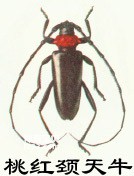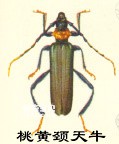Pink-necked beetles are distributed throughout all provinces in China, and abroad in North Korea and the former Soviet Union. It is the main pest of peach trees. Plums, plums, cherries, apples, and apricots in the south and pears and apricots in the north are also seriously affected.
Adults There are two color types: one is the "red neck type" with a shiny black body and brownish red chest, and the other is the "black neck" type with the entire body black and shiny. According to preliminary understanding, there are "red-necked" and "black-necked" individuals in Fujian and Hubei, while only "red-necked" individuals are seen in places north of the Yangtze River such as Shanxi and Hebei. The adult body length is about 28-37 mm, and the body is black and shiny. Most of the front and back of the chest are shiny brown-red or completely black. The head is black, with many horizontal wrinkles on the ventral surface, and a deep depression between the eyes on the top of the head. The antennae are blue-purple, with a leaf-like protrusion on each side of the base. There is one spinous process on each side of the chest, and four tumor processes on the back. The elytra surface is smooth, the base is wider than the prothorax, and the rear end is narrower. The body of the male insect is smaller than that of the female insect. The ventral surface of the prothorax is densely covered with indentations, and the antennae extend five sections beyond the insect body. The female insect has many transverse wrinkles on the ventral surface of the prothorax, and the antennae extend two sections beyond the insect body.

Egg: Oval, milky white, about 6-7 mm long.
Larvae: Mature larvae are about 42-52 mm long, milky white, and have a broad chest. Each section of the front half of the body is slightly flat and rectangular, and the back half is slightly cylindrical. There are dense yellow-brown fine hairs on both sides of the body. There are 4 horizontal yellow-brown patches on the front half of the pronotum, and the two on the back are each horizontally rectangular, with a depression in the center of the front edge. The back of the back half is colored and has vertical wrinkles; the yellow-brown patches on both sides are slightly rectangular. Triangular in shape. The back and ventral surfaces of each section of the trunk are slightly raised and have horizontal wrinkles.
Pupa: The body is about 35 mm long. It is milky white at first and gradually turns to yellowish brown. There is a spine on each side of the chest.
Biological characteristics: This insect usually has one generation every two years (sometimes three years), and overwinters as young larvae (first year) and mature larvae (second year). Adults appear between May and August; the emergence period of adults in various places is delayed from south to north. Adults appear most abundantly in Fujian and southern provinces in late May; in Hubei, most adults appear in early to mid-June; adults finally appear in early July. Adults peak in Hebei in early to mid-July; adults in Shandong appear from early July to mid-August; adults in Beijing peak from mid-July to mid-August.
After emergence, the adults stay in the trunk tunnel for 3-5 days and then go out for activities. Female adults will fly away when disturbed, while male adults will often run away or fall from trees into the grass. The adults begin to mate and lay eggs after 2-3 days of going out. It is common for adults to perch or mate on branches at noon. The eggs are laid in cracks in the bark of branches. Young and strong trees only have cracks on their trunks, while old trees have cracks at the base of their trunks and main branches where eggs can be laid. Generally, most eggs are laid on tree trunks within 35 cm of the soil surface, and the egg-laying period lasts 5-7 days. The adults die shortly after laying eggs.

The eggs hatch into larvae in 7-8 days. After hatching, the larvae feed downwards on the phloem, grow to 6-10 mm that year, and overwinter in this cortex. The larvae resume their activities in the spring of the following year and continue to feed downward from the cortex to the surface of the xylem. They first form a short and shallow oval tunnel with a depression in the middle. In summer, when the body length is about 30 mm, they feed from the middle of the tunnel into the depth of the xylem. The tunnels are irregular, and the larvae that grow up in winter overwinter in the tunnels. The infestation continues in the spring of the third year, and when the larvae mature from April to June, they use secretions to coat wood chips and pupate in the cavity. The larval stage lasts about one year and 11 months. The pupal chamber is at the end of the borer tunnel. Before the grown larvae overwinter, they have prepared an emergence hole leading to the outside world. Before emerging and going out, the bark outside the hole remains intact. The larvae feed from top to bottom, forming curved and irregular holes in the trunk. The tunnel can reach 2-3 inches below the surface of the main trunk. The total length of the larvae's tunnels is about 50-60 cm. A large amount of reddish-brown feces is often accumulated outside the boreholes of tree trunks and on the ground. Severely damaged trees have hollow trunks, weakened trees, and even die.
Control methods: The adult emergence period (May-July) generally does not exceed 10 days in an orchard, and is relatively neat. During this period, catching and beating the adults will achieve greater results. People in Huailai County, Hebei Province discovered that pink-necked longhorned beetles rest in groups from the bottom of the tree crown to the base of the trunk between 12 and 13 o'clock. They can be captured for several days and the damage can basically be controlled.
The peach-necked longhorned beetle specializes in eating peach trees. The difference between it and the pink-necked longhorned beetle is that the back of the chest and the ends of the feet are yellow.
animal tags:
We created this article in conjunction with AI technology, then made sure it was fact-checked and edited by a Animals Top editor.